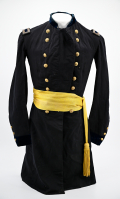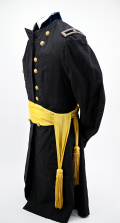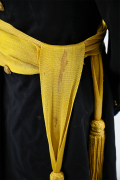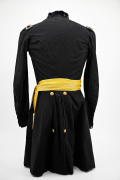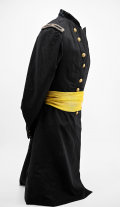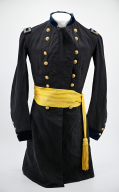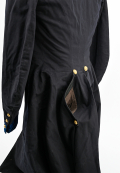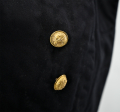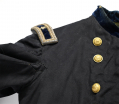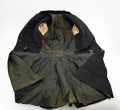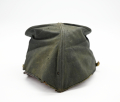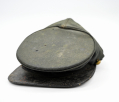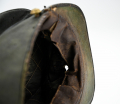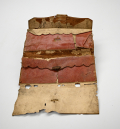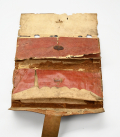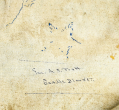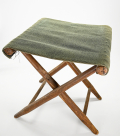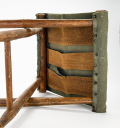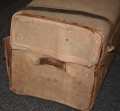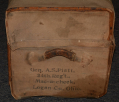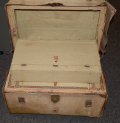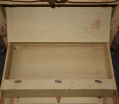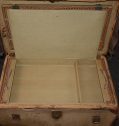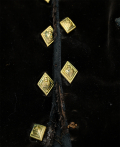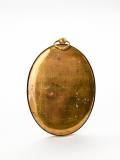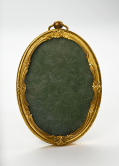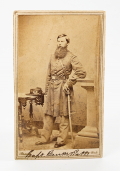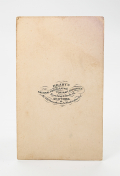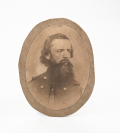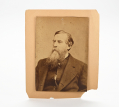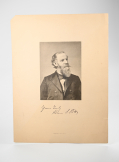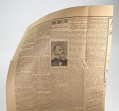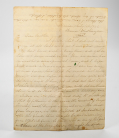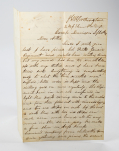site search
online catalog
LARGE GROUP OF ITEMS FROM OHIO’S BRIGADIER GENERAL ABRAM PIATT – COMMANDER OF THE PIATT ZOUAVES

$35,000.00
Quantity Available: 1
Item Code: 1179-178
Shipping: Determined by Method & Location of buyer
To Order:
Call 717-334-0347,
Fax 717-334-5016, or E-mail
Abram S. Piatt was born in Cincinnati, Ohio, May 2, 1821. He was educated at the Athenaeum and at Kinmount Academy in Cincinnati, and then engaged in farming in the Macacheek Valley. He began to study law in 1846, and in that year founded a paper, which he afterwards edited for several years, called the "Macacheek Press." He enlisted in the volunteer army in 1861, was commissioned colonel of the 13th Ohio infantry on April 20, and in July raised and equipped at his own expense the 1st Ohio Zouave regiment, which became the 34th Ohio infantry, and of which he was commissioned colonel on Sept. 2. He then began to organize another regiment, with the intention of forming a brigade, but before it was completed, he was ordered to the front, and was made brigadier-general of volunteers, April 28, 1862. Piatt commanded the post at Winchester, Va., for a short time, and subsequently he participated in the second battle of Bull Run and the battle of Fredericksburg. Of his service in the field the “WEST LIBERTY BANNER” reported “In the frightful Battle of Fredericksburg General Piatt led three charges against the enemy and was noted throughout for calm courage in the heat of action amid hopeless slaughter. Throughout his whole military career, he was conspicuous for those sterling qualities which make the American citizen soldier the most reliable and formidable in the world.” He resigned from the army, Feb. 17, 1863, and resumed farming, became a member of the National Greenback-Labor party and was its candidate for governor in 1879. He was a member of the Patrons of Husbandry serving as its state lecturer for two years, and he contributed poems to his own publication and to the Cincinnati "Commercial." General Piatt died in 1908 in Monroe Township, Ohio and is buried in nearby Piatt Cemetery.
First in the group is General Piatt’s forage cap. It is made of a dark blue wool broadcloth that has faded from exposure to the sun and become dirty due to years of storage. The exterior body has three small moth nips in the top of the crown with several smaller bites scattered over the back of the cap. On the front, under the sloping crown, are two holes about the size of a dime with smaller satellite holes nearby. There are two stress separations, one on each side near the three-piece staff side buttons. The leather chinstrap is gone. The leather visor has a bound edge and the underside is lined with a green leather that shows moderate dirt and wear. The interior of the cap has a badly worn, low, ox-blood sweatband that despite being creased and broken in two areas, is complete. Interior is lined with black polished cotton and is quilted.
Next, is Piatt’s double-breasted frock coat with brigadier general’s shoulder straps. The coat is made of a dark blue wool broadcloth with a dark royal blue felt on the collar and the functioning cuffs. Buttons on the front are three-piece US Staff buttons arranged in eight rows of two. All are present, all are marked “SCOVILLE MFG CO. – WATERBURY” and all are original to the coat. Buttons are free of dents and retain their gilt finish. The six cuff buttons (three on each cuff) and the four on the back match the rest in maker’s mark and condition. The double-bordered brigadier general shoulder straps are held to the coat by a hook and eye arrangement in each corner of the straps. Backs are lined with black polished cotton which was handsewn into place. The straps have a double border of gold bullion thread with a black felt rank field and a single five-pointed star done in gold bullion with a single sequin at center. The strap on the left shoulder is still anchored to the coat but does have a loose strand on the outer jaceron border and much of the gilt on the gold bullion thread making up the exterior border, has worn away and appears silver. The right strap is only attached by the front two corners and the line of dead bullion that marks the border between the two rows of gold bullion is loose. The wear and fading of the gilt on this strap matches its mate. Also present in the shoulder area are small cloth pockets to accept the iron mounting bar on the back of a pair of epaulettes. These are made of the same fine material as the coat and are barely noticeable. All exterior seams are tight. Buttonholes look to be machine sewn while the dark royal blue felt on the collar and cuffs was applied by fine hand stitching. The exterior of the coat does display some light surface dirt on the skirt and several small moth bites but nothing concentrated and nothing that really detracts form the impressiveness of the garment. Most of the wear seems to be confined to the top collar seam where sweat has caused some separations and moth action has removed small amounts of felt.
The interior of the coat is lined in the back and skirt with black polished cotton that is slowly oxidizing to a dark green. There are some stress separations in the collar area but these are limited. Overall, the lining is in excellent condition. The chest area is lightly padded and is lined with a dark blue wool to match the exterior of the coat. Each side of the breast has a deep horizontal pocket. The bottom edge of the left breast pocket shows some scattered holes from moth action, otherwise the rest of the lining is very good. At the front waist the lining has two small leather flaps approx. 1.75 x 2.50 inches long with three hook and eye attachments on each. When hooked they give the coat a tighter, closer fit. Sleeves are lined with white muslin. The armpit areas have been reinforced with a strip of white linen. The seams where the sleeve lining meets the body lining show some wear but are holding well. Tail pockets are present in the skirt.
Present with the group is a single, loose brigadier general’s shoulder strap. The infantry blue field is badly worn but the gold bullion border and single star are in very good condition. The board has a tin plate at center with a badly worn brown polished cotton underlining.
Group also includes General Piatt’s gold colored sash. The body is in very good condition with only minor spots of discoloration in two or three areas. The acorns and tassels are good. Item does exhibit some light surface dirt.
The General’s hat cord and wallet are also present. The hat cord is in perfect condition. The leather tri-fold wallet does show some surface wear and dirt to the outside. The closure strap works properly and when opened the wallet has several compartments for bills, paper, coins or stamps. Most compartments are lined with a white kid leather. Interior shows much wear from age and use. One pocket has a rusted latch and loose escutcheon while another pocket is split.
Also in the group is a badly worn pistol box marked under the top flap with “GENERAL A. S. PIATT” in period ink. The back panel and flap of the box are still in one piece however, the sides and bottom panel with brass finial have all come loose but are present.
With the group is the Generals saddle blanket or shabraque. It is made of dark blue wool with an underside entirely lined with a white canvas material. Folded in half as it would be while on the horse the item meas. approx. 34.50 inches wide by 24.50 inches high. It has a double border of gold bullion tape with each border being 2.50 inches wide. The bullion tape has a scalloped edge and a crosshatched center and other than showing moderate surface dirt from age and storage, is in nice condition. The rear, lower corner of each side has a spread-winged eagle fashioned of gold bullion thread and sequins. One side has a single five-pointed star done of the same above the eagle. The star is missing from the opposite side but its outline is present. The blue cloth has retained its color over the years but the edges show some light fraying and hanging single threads here and there.
General Piatt’s folding camp stool is also present with the group. The wood frame is in excellent condition with three wide straps of burlap under the heavy green cloth seat. The seat is tacked to the frame by twenty-two haphazardly placed black tacks. Seat is doubled over for strength.
Also, part of the group is Piatt’s trunk. It meas. approx. 28.50 long x 19.00 inches wide x17.00 inches high. The trunk is held inside a tan canvas lining bordered in brown leather. Cover shows some light wear but is otherwise in very nice condition. One side of the trunk cover is stenciled with “GENERAL A. S. PIATT, 34TH REG’T., MAC-A-CHEEK, LOGAN COUNTY, OHIO” in four lines while the opposite side is stenciled with “A.P.” The top of the lid has a paper label with a handwritten address. The name at top is obstructed by wear to the label but the second and third lines read “GARRETT PARK, MARYLAND.” Under the cover, the leather of the trunk is in very good condition. The lid has a very nice embossed decoration of a bowl overflowing with fruit. Upon lifting the lid there is a domed upper compartment with a door that is held closed by brass latches. The lower compartment has a removable storage tray with a wide, cavernous storage compartment at bottom.
The group contains a little girl’s jacket which in style is reminiscent of a doublet. It is made of a brown wool felt material with black edging on the neck, front placket and skirt. There is a black edged slanted horizontal pocket on the left chest. The cuffs have a horizontal line of the black edging that slants upward from the inner edge. Extending from this are three vertical lines of the same black edging material, each with its own decorative diamond shaped brass buttons. The front placket is held closed by a hook and eye device at the collar. Only the eye remains. Down the front on each side are seven diamond shaped brass buttons decorated with a Scottish thistle. The left shoulder has an epaulette of lattice worked black braid anchored to the collar edge by a single button. The interior is lined with black polished cotton while the sleeves have white muslin. All is in good condition but for a 2-inch vertical separation in the neck area.
There are several photographs with the group.
The first is a full standing view of Captain Benjamin McCullough Piatt by Brady. This Benjamin Piatt is believed to be a cousin of the General. Captain Piatt is posed standing next to a low table and leaning against a podium with one hand resting on the hilt of his sword. On the table is his dark, low crowned, slouch hat complete with plume and “U.S.” in a wreath on the front of the crown. The captain wears a dark frock coat and light trousers. His captains shoulder straps are clearly visible on his coat. He also wears a sword belt with rectangular plate and shoulder support strap. Attached is his Model 1850 field and staff sword. Contrast and clarity are excellent. Mount and paper are very good. Period ink ID at bottom center of mount reads “CAPT. BEN. M. PIATT.” Reverse has a photographer’s imprint for BRADY… NEW YORK AND WASHINGTON, D.C.
Benjamin M. Piatt was born in Kentucky. He was commissioned a captain in US Volunteer Adjutant General’s Department on May 16, 1862. He was appointed major by brevet on March 2, 1865. After the war ended he stayed in service and was reduced to 2nd lieutenant. He did receive two brevet promotions, one to 1st lieutenant for his services at Chancellorsville and one to captain for his services at Gettysburg. Both brevets came on July 2, 1867. Piatt retired from the Army on December 31, 1870. He died in Cincinnati on April 17, 1885 and is buried in Saint Mary’s Cemetery, Fort Mitchell, Kentucky.
The second image is a wartime view of General Abram S. Piatt on paper and cut into a 4.00 x 3.00 inch oval. The General is shown from the chest up in uniform and posed in a right profile.
Third is a 5.00 x 7.00 inch chest-up view of the Captain Benjamin Piatt in later years wearing a dark civilian suit. The photo is mounted to a paper backing. Contrast and clarity are very good.
Lastly is an 8.00 x 10.00 sheet with a printed 5.00 x 7.00 view of the General in a dark civilian suit over a facsimile of his signature. Again, the contrast and clarity are excellent.
The group also contains two long newspaper articles relating to General Piatt’s life and death.
The last two items in the group are letters written by two members of the Worthington family. One is written by a woman who describes the funeral of a member of Piatt’s regiment. The 34th Ohio while the other letter is written by James Worthington who served in the regiment. In that letter Worthington describes the uniform worn by the Piatt Zouaves, “dark blue jackets with two red stripes on each arm and bound all the way around in the same way.” Also, “light blue pants coming down to the ankles and from there filled out with canvas leggings and two red stripes on each leg.”
This is a large and interesting grouping from a general officer worthy of any Civil War museum or collection. [sr] [ph:m/L]
Will require additional shipping charge, particularly due to the weight and size of the trunk; pick up at the shop or one of the shows we participate in may be preferable.
~~~~~~~~~~~~~~~~~~~~~~~~~~~~~~~~~~~
THIS ITEM, AS WITH ALL OTHER ITEMS AVAILABLE ON OUR WEB SITE,
MAY BE PURCHASED THROUGH OUR LAYAWAY PROGRAM.
CLICK HERE FOR OUR POLICIES AND TERMS.
THANK YOU!
Inquire About LARGE GROUP OF ITEMS FROM OHIO’S BRIGADIER GENERAL ABRAM PIATT – COMMANDER OF THE PIATT ZOUAVES
For inquiries, please email us at [email protected]
Most Popular
Historical Firearms Stolen From The National Civil War Museum In Harrisburg, Pa »
Theft From Gravesite Of Gen. John Reynolds »
Cavalry Carbine Sling Swivel »
Fine Condition Brass Infantry Bugle Insignia »
featured item
RARE M1840 U.S. ARTILLERY OFFICER’S SABER MADE BY AMES BUT ETCHED AND RETAILED BY SCHUYLER, HARTLEY AND GRAHAM: THE ONE IN THE BOOK!
This is an extremely rare M1840 U.S. artillery officer’s saber made by Ames but etched and retailed by Schuyler, Hartley and Graham. Thillmann knew only of this one example, and until it was found it was unclear if Schuyler, Hartley and Graham… (870-637). Learn More »



